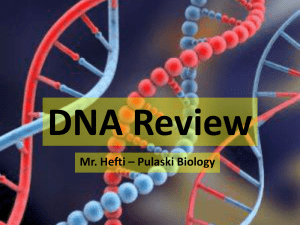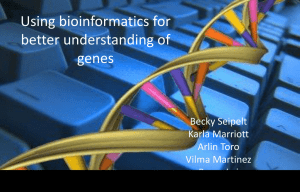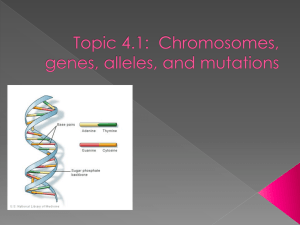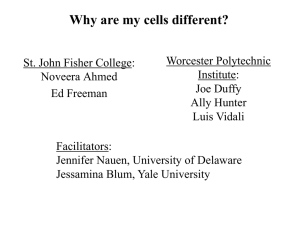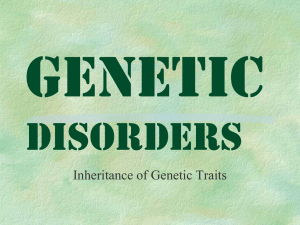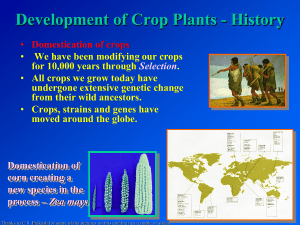CHEM642-12 Powerpoint
advertisement
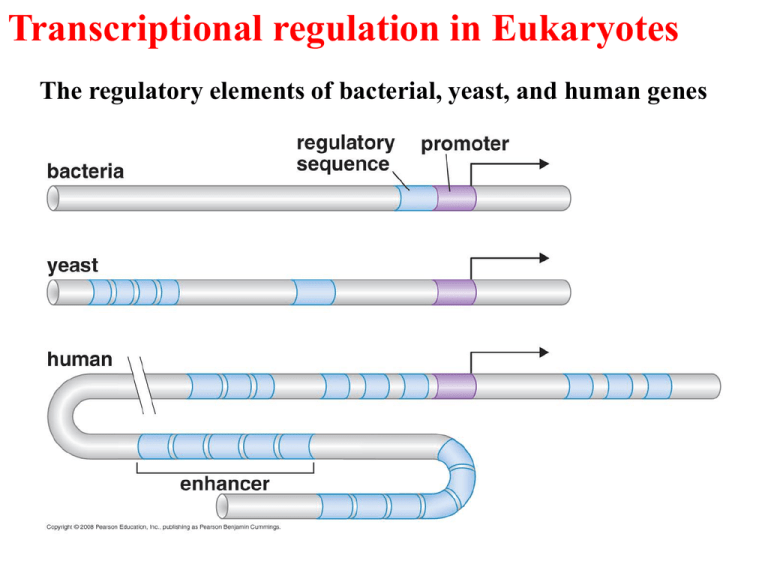
Transcriptional regulation in Eukaryotes The regulatory elements of bacterial, yeast, and human genes Regulation of gene expression in Eukaryotes The gene control region of a typical eucaryotic gene. CONSERVED MECHANISMS OF TRANSCRIPTIONAL REGULATION FROM YEAST TO MAMMALS Activators have separate DNA-binding and activating functions Gal 4 bound to its site on DNA The regulatory sequences of the yeast GAL 1 gene Domain swap experiment The yeast two-hybrid assay DNA-binding motifs in gene regulatory proteins (repressors; activators) Double-helical structure of DNA. The major and minor grooves on the outside of the double helix are indicated. The atoms are colored as follows: carbon, dark blue; nitrogen, light blue; hydrogen, white; oxygen, red; phosphorus, yellow. The outside of DNA duplex can be read by proteins A DNA recognition code. The edge of each base pair, seen here looking directly at the major or minor groove, contains a distinctive pattern of hydrogen bond donors, hydrogen bond acceptors, and methyl groups. From the major groove, each of the four base-pair configurations projects a unique pattern of features. From the minor groove, however, the patterns are similar for G– C and C–G as well as for A–T and T–A. Short DNA sequences are fundamental components of genetic switches Gene regulatory proteins contain structural motifs that can read DNA sequences The binding of a gene regulatory protein to the major groove of DNA. Only a single contact is shown. Typically, the protein-DNA interface would consist of 10 to 20 such contacts, involving different amino acids, each contributing to the strength of the protein–DNA interaction. Two examples of specific amino-acid-base pair interactions in DNA-protein binding Eukaryotic regulators use a range of DNA-binding domains, but DNA recognition involves the same principles as found in bacteria DNA recognized by a Homeodomain Zinc finger domain Leucine zipper Leucine zipper motif mediates both DNA binding and protein dimerization Helix-loop-helix Activating regions are not well-defined structures RECRUITMENT OF PROTEIN COMPLEXES TO GENES BY EUKARYOTIC ACTIVATORS Activator recruit the transcriptional machinery to the gene Activation of transcription through direct tethering of mediator to DNA Activator also recruit nucleosome modifiers that help the transcriptional machinery bind at the promoter or initiate transcription Action at a distance: loop and insulators Insulators block activation by enhancers Appropriate regulation of some groups of genes requires locus control regions The cluster of b-like globin genes in humans. (A) The large chromosomal region shown spans 100,000 nucleotide pairs and contains the five globin genes and a locus control region (LCR). (B) Changes in the expression of the b-like globin genes at various stages of human development. Each of the globin chains encoded by these genes combines with an a-globin chain to form the hemoglobin in red blood cells (see Figure 7–115). Model for the control of the human b-globin gene. The diagram shows some of the gene regulatory proteins thought to control expression of the gene during red blood cell development). Some of the gene regulatory proteins shown, such as CP1, are found in many types of cells, while others, such as GATA-1, are present in only a few types of cells—including red blood cells—and therefore are thought to contribute to the cell-type specificity ofb-globin gene expression. As indicated by the double-headed arrows, several of the binding sites for GATA-1 overlap those of other gene regulatory proteins; it is thought that occupancy of these sites by GATA-1 excludes binding of other proteins. Once bound to DNA, the gene regulatory proteins recruit chromatin remodeling complexes, histone modifying enzymes, the general transcription factors and RNApolymerase to the promoter SIGNAL INTEGRATION AND COMBINATORIAL CONTROL Activators work synergistically to integrate signals Transcriptional synergy. In this experiment, the rate of transcription produced by three experimentally constructed regulatory regions is compared in a eucaryotic cell. Transcriptional synergy, the greater than additive effect of the activators, is observed when several molecules of gene activator protein are bound upstream of the promoter. Synergy is also typically observed between different gene activator proteins from the same organism and even between activator proteins from widely different eucaryotic species when they are experimentally introduced into the same cell. This last observation reflects the high degree of conservation of the transcription machinery. Synergy resulted from cooperative binding of activators Signal integration: The HO gene is controlled by two regulators- one recruits nucleosome modifiers and the other recruits mediators Signal integration: Cooperative binding of activators at the human b-interferon gene The enhancesome structure and the DNA sequences they bound Combinatorial control lies at the heart of the complexity and diversity of eukaryotes Combinatorial control of the mating-type genes from yeast TRANSCRIPTIONAL REPRESSORS Repression of GAL1 gene in yeast SIGNAL TRANSDUCTION AND THE CONTROL OF TRANSCRIPTIONAL REGULATORS Signals are often communicated to transcriptional regulators through signal transduction pathways STAT (signal transducer and activator of transcription) pathway The MAPK (mitogen-activated protein kinase) pathway Signals control the activities of eukaryotic transcriptional regulators in a variety of ways (Unmasking an activating region; transport into and out of the nucleus) Activators and repressors sometimes come in pieces GENE “SILENCING” BY MODIFICATION OF HISTONES AND DNA Silencing in yeast in mediated by deacetylation and methylation of histones In Drosophila, HP1 recognizes methylated Histones and condenses chromatin DNA methylation is associated with silenced genes in mammalian cells EPIGENETIC GENE REGULATION The inheritance of gene expression patterns, in the absence of both mutation and the initiating signal, is called epigenetic regulation Some states of gene expression are inherited through cell division even when the initiating signal is no longer present Patterns of DNA methylation can be maintained through cell division Stable patterns of gene expression can be transmitted to daughter cells Evidence of Epigenetic Inheritance Using transcription factors to reprogram somatic cells into embryonic stem cells Late-stage mouse embryo entirely derived from a fibroblast cells expressing the embryonic stem cell transcription factors Oct4, Sox2, c-Myc, and Klf4.


